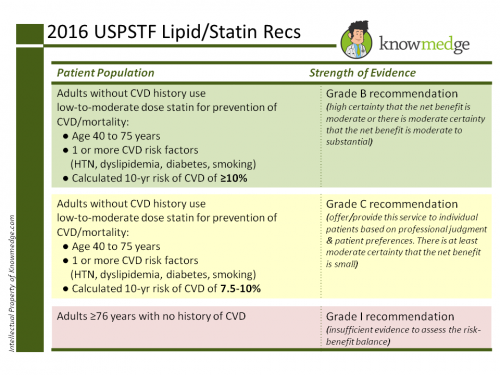
These include the 2013 American College of Cardiology/American Heart Association (ACC/AHA) guideline and the 2017 American Academy of Clinical Endocrinology (AACE) guideline. Several heavily debated treatment guidelines discuss the role of statins in treating hyperlipidemia. 14 Additionally, they have been shown to improve meaningful patient-oriented outcomes, such as major CV events (CVEs), in both primary and secondary prevention. Statins have repeatedly been proven effective for reducing LDL-cholesterol (LDL-C) and triglyceride levels while raising HDL-cholesterol (HDL-C) levels. 11,12 Coformulated statin and niacin products (niacin/lovastatin and niacin/simvastatin) were removed from the market in 2016 based on a lack of evidence that adding niacin in statin-treated patients further reduces cardiovascular (CV) outcomes beyond what is seen with statins alone. These include the combination of atorvastatin and amlodipine, a calcium channel blocker (CCB) indicated for hypertension, and the combination of simvastatin and ezetimibe, an intestinal cholesterol-absorption inhibitor also indicated for hypercholesterolemia. 8-10 The role of branded agents in therapy is limited given the widespread availability of generic options.Ītorvastatin and simvastatin are also available generically in several combination products. 2-7 Three available branded formulations are pitavastatin (Livalo), simvastatin oral suspension (FloLipid), and lovastatin extended-release (Altoprev). Of the seven different statins on the market, six are available generically ( TABLE 1). This article, which focuses on generic statins, will highlight the debate about statins’ role in therapy, discuss proper use, and explore evidence surrounding two major adverse events. 1 However, frequent use of these agents has led to continual scrutiny of their safety and ongoing debate about their role in therapy. With a variety of generic options on the market and strong evidence backing their use, statins are some of the most widely prescribed medications in the world.

The cornerstone of dyslipidemia treatment involves the use of 3-hydroxy-3-methylglutaryl-coenzyme A reductase inhibitors, more commonly known as statins.

Individualized patient-care plans can be developed based on data from important clinical studies, differences in guidelines, and current management recommendations for two major adverse events associated with statin use. With six statins available generically, the selection of an appropriate agent may be determined based on drug-specific factors, including dosing considerations, drug interactions, and adverse events. ABSTRACT: Statins are a class of medications widely used for primary and secondary prevention of cardiovascular events.


 0 kommentar(er)
0 kommentar(er)
